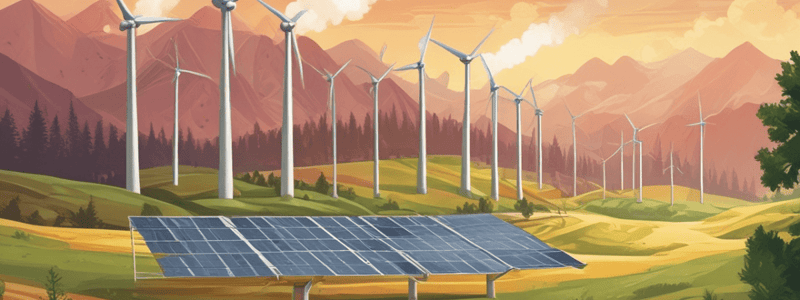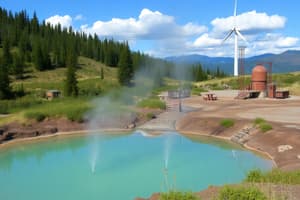Podcast
Questions and Answers
What is the ideal temperature range for maximum photosynthesis rate?
What is the ideal temperature range for maximum photosynthesis rate?
- 30°C to 40°C
- 15°C to 25°C
- 20°C to 30°C (correct)
- 25°C to 35°C
What is the energy density of charcoal?
What is the energy density of charcoal?
- 30 MJ/kg (correct)
- 10 MJ/kg
- 20 MJ/kg
- 40 MJ/kg
What is the boiling point of ethanol?
What is the boiling point of ethanol?
- 78°C (correct)
- 70°C
- 80°C
- 75°C
What is the percentage of methane gas in biogas?
What is the percentage of methane gas in biogas?
What percentage of the world's energy is accounted for by biomass?
What percentage of the world's energy is accounted for by biomass?
What is producer gas used for?
What is producer gas used for?
What is the primary source of energy for biomass?
What is the primary source of energy for biomass?
What is the process by which plants convert solar energy into carbohydrates?
What is the process by which plants convert solar energy into carbohydrates?
What is the term for the wavelengths of light used by plants for photosynthesis?
What is the term for the wavelengths of light used by plants for photosynthesis?
What is the term for the gaseous fuel produced from biomass through anaerobic fermentation?
What is the term for the gaseous fuel produced from biomass through anaerobic fermentation?
What is the purpose of seeding in anaerobic digestion?
What is the purpose of seeding in anaerobic digestion?
What is the ideal pH range for the methane-forming stage of anaerobic digestion?
What is the ideal pH range for the methane-forming stage of anaerobic digestion?
What is the purpose of mixing and stirring in anaerobic digestion?
What is the purpose of mixing and stirring in anaerobic digestion?
What is the classification of biogas plants based on their operation?
What is the classification of biogas plants based on their operation?
What is the purpose of retention time in anaerobic digestion?
What is the purpose of retention time in anaerobic digestion?
What is the main biomass resource obtained from crops?
What is the main biomass resource obtained from crops?
What is the primary advantage of biomass energy?
What is the primary advantage of biomass energy?
What is the composition of biogas?
What is the composition of biogas?
What is the anaerobic process in biomass slurry?
What is the anaerobic process in biomass slurry?
What is the primary condition required for anaerobic digestion of biomass?
What is the primary condition required for anaerobic digestion of biomass?
What is the primary function of hydrolysis in the biochemical process of biomass conversion?
What is the primary function of hydrolysis in the biochemical process of biomass conversion?
What is the recommended pH value for the digestion of biomass slurry?
What is the recommended pH value for the digestion of biomass slurry?
What is the main advantage of anaerobic digestion in terms of waste management?
What is the main advantage of anaerobic digestion in terms of waste management?
What is the role of methane-forming bacteria in anaerobic digestion?
What is the role of methane-forming bacteria in anaerobic digestion?
What is the purpose of adding nutrients to the digestion slurry?
What is the purpose of adding nutrients to the digestion slurry?
What is the main advantage of the floating drum type biogas plant?
What is the main advantage of the floating drum type biogas plant?
What happens to the pressure inside the digester in a fixed dome type biogas plant?
What happens to the pressure inside the digester in a fixed dome type biogas plant?
What is the main challenge in converting biomass into biogas in hilly regions?
What is the main challenge in converting biomass into biogas in hilly regions?
What is the purpose of the displacement tank in a modified fixed dome type biogas plant?
What is the purpose of the displacement tank in a modified fixed dome type biogas plant?
What is the primary purpose of incineration in biomass conversion?
What is the primary purpose of incineration in biomass conversion?
What is the approximate calorific value of biogas?
What is the approximate calorific value of biogas?
Which method is used to increase the temperature of biomass slurry in the digester in hilly regions?
Which method is used to increase the temperature of biomass slurry in the digester in hilly regions?
What is the product obtained by pyrolysis at high temperature?
What is the product obtained by pyrolysis at high temperature?
What is the minimum percentage of biogas that can be successfully blended with gasoline to run an IC engine?
What is the minimum percentage of biogas that can be successfully blended with gasoline to run an IC engine?
What is the purpose of locating a biogas plant near an area where biomass is generated?
What is the purpose of locating a biogas plant near an area where biomass is generated?
What is the purpose of a leachate collection system in landfill reactors?
What is the purpose of a leachate collection system in landfill reactors?
What is the main advantage of community biogas plants?
What is the main advantage of community biogas plants?
What is the ideal moisture content for biogas production in landfill reactors?
What is the ideal moisture content for biogas production in landfill reactors?
What is the purpose of using a floating gas holder in a biogas plant?
What is the purpose of using a floating gas holder in a biogas plant?
What is the purpose of lining the landfill site with plastic liner and clay?
What is the purpose of lining the landfill site with plastic liner and clay?
Flashcards are hidden until you start studying
Study Notes
Biomass Energy Resources
- Biomass is organic material that can be converted into energy through combustion or metabolic processes
- Main sources of biomass energy: wood, agricultural waste, urban waste, and forest waste
Photosynthesis
- Process by which plants convert solar energy into chemical energy (carbohydrates)
- Requires chlorophyll, carbon dioxide, and water
- Plants absorb red and blue light, but not green light, which is why they appear green
- Biomass production efficiency: 28% of used energy is converted into carbohydrates
Conditions for Photosynthesis
- Temperature: 20-30°C for maximum rate
- Carbon dioxide concentration: increases photosynthesis
- Oxygen concentration: reduces photosynthesis
- Water: increases photosynthesis
- Intensity and wavelength of solar radiation: increases photosynthesis with PAR (photo synthetically active radiation)
Biomass
- Can be used in its original form or transformed into solid, liquid, or gaseous fuels
- Examples of biomass fuels: fuel wood, charcoal, fuel pellets, bioethanol, biogas, producer gas, and biodiesel
Biofuels
- Fuel wood: most common source of biomass energy, energy density of 16-20 MJ/kg
- Charcoal: obtained from wood, energy density of 30 MJ/kg
- Fuel pellets: formed from crop residues, energy density of 16-20 MJ/kg
- Bioethanol: derived from sugarcane, starch, or cellulose, energy density of 26.9 MJ/kg
- Biogas: gaseous fuel produced from biomass, energy density of 23 MJ/m3
Biomass Resources
- Forests: source of fuel wood, charcoal, and producer gas
- Agricultural residues: straw, rice husk, groundnut shell, coconut shell, and sugarcane bagasse
- Energy crops: sugar plants, starch plants, and oil-producing plants
- Urban waste: garbage, sewage, and liquid waste
- Aquatic plants: water hyacinth, seaweed, algae, and kelp
Advantages and Disadvantages of Biomass Energy
- Advantages: renewable, storable, waste management, indigenous, economic development, sanitation, and fertilizers
- Disadvantages: low energy density, labor-intensive, and large land area required
Biogas
- Gaseous fuel produced from biomass through anaerobic digestion
- Composition: 50-60% methane, 25-35% carbon dioxide, and 5% hydrogen and other gases
- Energy density: 23 MJ/m3
- Uses: cooking, heating, lighting, and running small IC engines
Anaerobic and Aerobic Processes
- Anaerobic: process occurring in absence of oxygen, used in biogas production
- Aerobic: process occurring in presence of oxygen
Anaerobic Digestion
- Process of biogas production from biomass slurry
- Factors favoring digestion: wetness, warmness, and darkness
- Three stages: hydrolysis, acid formation, and methane formation
- Digester: airtight equipment used for anaerobic digestion
Advantages of Anaerobic Digestion
- Energy production from waste materials
- Fertilizer production
- Waste management
- Improved sanitation and hygiene
- Containment of odors
Raw Materials for Biogas
- Waste: industrial, agricultural, urban, and forest waste
- Cultivated materials: rice, wheat, and cereals
- Harvested materials: agricultural crops and residues
Factors Affecting Biogas Production
-
Temperature: 20-65°C
-
Pressure: 6-10 cm of water column
-
Water: 9-10% solid content
-
pH value: 6-7.5
-
Feeding rate: uniform feeding rate
-
Presence of nutrients: carbon, nitrogen, and other nutrients
-
Seeding: adding digested slurry to fresh feed
-
Mixing and stirring: mixing of biomass slurry
-
Retention time: 50-60 days
-
Toxic substances: presence of pesticides, detergents, and ammonia
-
Type of biomass: cow dung, poultry manure, etc.### Advantages and Disadvantages of Fixed Drum Type Biogas Plant
-
Lower cost
-
No corrosion problem
-
Better heat insulation
-
No maintenance required
Disadvantages of Fixed Drum Type Biogas Plant
- Gas production per cubic meter of the digester is less
- Variable pressure of biogas
- More risk of leakage due to higher pressure of gas
- More risk of explosion
- Complex installation
Properties of Biogas
- Composition: 60% methane, 40% carbon dioxide, and traces of hydrogen, hydrogen sulphide, and other gases
- Calorific value: 5,600 kcal/m3 or 4,250 kcal/kg
- Stoichiometric air-fuel ratio: 5.27 by volume
- Calorific value of mixture: 767 kcal/m3, equivalent to 85% of gasoline
Application of Biogas in IC Engine
- Biogas cannot be used in IC engine without modification
- Blending biogas with petrol and diesel can run IC engine with small modification
- A mixture of biogas and gasoline containing 5-10% biogas can be used as IC engine fuel, reducing gasoline consumption by 5-10% and fuel cost
Models of Biogas Plants
- Common circular digester with floating gas holder without water seal (KVIC design, India)
- Common circular fixed dome digester (China)
- Flexible gas type combined digester and gas holder
- Taper digester with floating gas holder (Nepal)
- Two-chamber rectangular digester with floating gas holder and water seal (Philippines)
- Jet digester with separate gas holder (Thailand)
- KVIC model
- PRAD model
- ASTRA model
- Ganesh model
Biogas Plant in Hilly Area
- Average temperature remains below 15°C in hilly regions
- Anaerobic bacteria grow and digest biomass in the temperature range of 25-75°C
- Methods to overcome temperature limitations:
- Hot water circulation
- Use of chemicals (e.g., urea and urine)
- Solar energy system
By-Product of Digestion
- By-products of digestion are shown in Figure
Location of Biogas Plant
- Considerations for locating a biogas plant:
- Distance from well or spring used for drinking water purposes
- Proximity to biomass generation area
- Availability of water source
- Open and exposed site for better performance
- Proximity to point of gas consumption
Size of Biogas Plant
- Considerations for deciding the size of the plant:
- Waste generation and animal/people population
- Gas requirements
- Volume of digester tank needed
- Size and shape of digestion tank
- Size of floating drum of the digester
Community Biogas Plants
- Advantages of community biogas plants:
- Efficient cooking fuel
- Electricity generation for various purposes
- Suggestions for improving productivity and efficiency:
- Using biogas in dual fuel engine to generate power
- Using hot exhaust to operate biogas plants at higher temperature
- Using additional materials (e.g., water plants with animal waste) to generate biogas
- New methods of biogas generation using bacterial support structures and recycling of spent slurry
Biomass Conversion Technologies
- Basic technologies to convert biomass into:
- Direct energy
- More valuable or convenient products
- Technologies:
- Incineration
- Thermochemical (pyrolysis)
- Biochemical
Incineration
- Burning or combustion of biomass to obtain useful heat
- Heat can be used for:
- Space heating and cooking
- Generating steam in boiler to run turbine with electric generator
Thermochemical (Pyrolysis)
- Conversion of biomass into more valuable and convenient fuels
- Process:
- Heating biomass in absence of air or partial combustion
- Products:
- Gaseous mixture (H2, CO, CO2, CH4, N2)
- Liquid (acetic acid, acetone, methanol, oil, and tar)
- Pure carbon char
Biomass Gasification
- Conversion of solid biomass into combustible gas mixture (carbon monoxide and hydrogen)
- Process:
- Partial combustion of biomass in absence of sufficient air
- Types of gasifiers:
- Fixed bed updraft gasifier
- Fixed bed down draft gasifier
- Cross draft gasifier
- Fluidized bed gasifier
Energy Recovery from Urban Waste by Landfill Reactors
- Municipal solid waste (MSW) disposal by controlled sanitary landfilling
- Biodegradable urban wastes are segregated and compacted to generate biogas
- Preparing the landfill site:
- Lining with plastic liner and clay to prevent groundwater contamination
- Leachate collection system to collect and recycle leachate
- Optimum moisture content of garbage: 60%
- Biogas production using anaerobic bacteria
- Temperature rises to 60°C during digestion
Studying That Suits You
Use AI to generate personalized quizzes and flashcards to suit your learning preferences.




